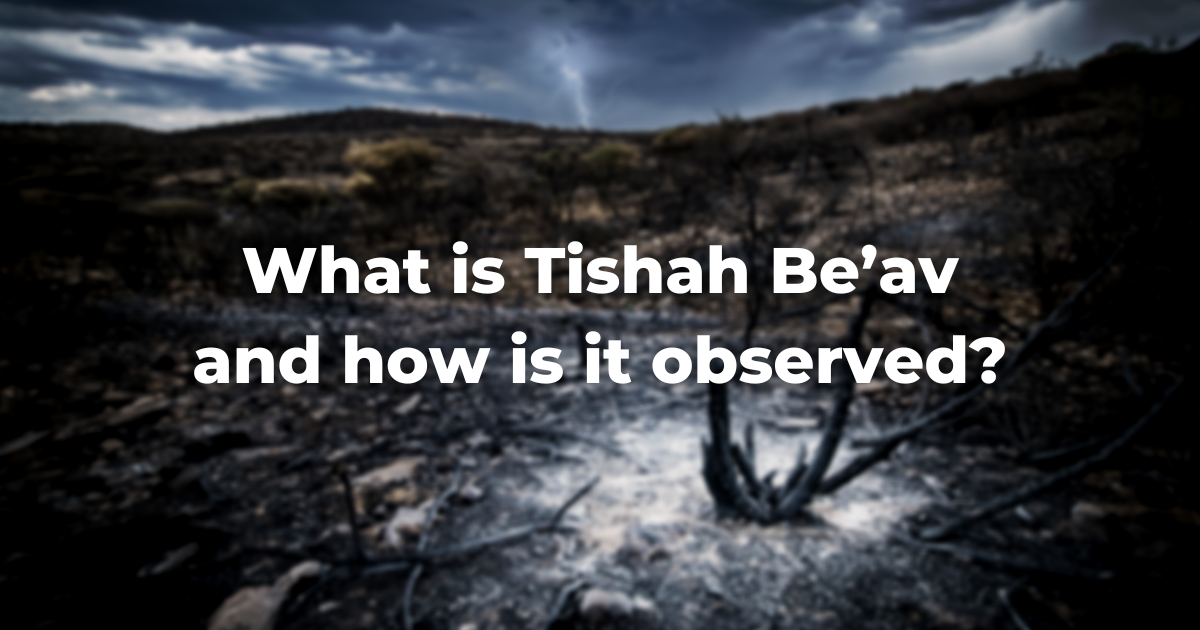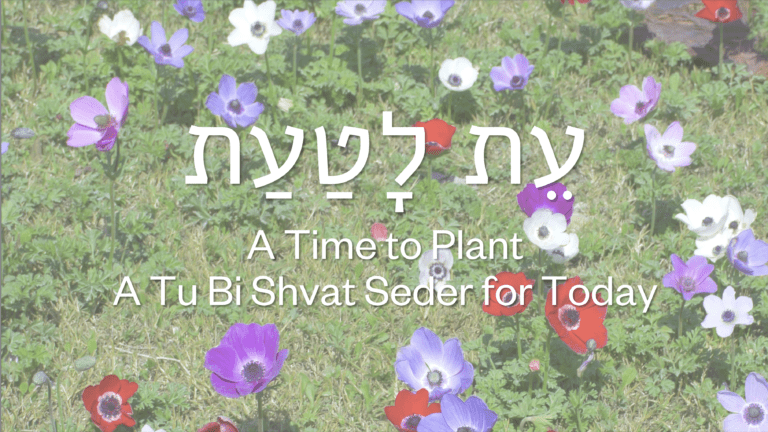What is Tishah Be’av? A full-day fast during the summer commemorating disasters experienced by the Jewish people throughout history, most notably, the destructions of the Temples in Jerusalem.
Aside from Yom Kippur, the only other full-day fast on the annual calendar is the fast of the Ninth of Av, popularly called by its Hebrew name, Tishah Be’av (also spelled Tisha B’av).
By common consensus, Tishah Be’av is the saddest day of the Jewish year.
According to tradition, it was on this very day that the First Temple was destroyed by the Babylonians in 586 B.C.E. and that the Second Temple was destroyed by the Romans in the year 70 C.E. Subsequently, many other tragedies have befallen the Jewish people on this date, including the expulsion of the Jews from Spain in 1492.
The observance of Tishah Be’av itself begins at sundown. A simple meal, commonly called the se’udah mafseket (“the meal of demarcation”) precedes the fast.
Many customs are associated with services on Tishah Be’av.
In some synagogues, the curtain that hangs before the Ark is replaced with a black one reminiscent of the pall that covers a casket on its last journey to the grave. Many synagogues also dim the lights, or even illuminate the sanctuary solely with candles so as to induce a mood of solemnity.
It is also customary to read the Book of Lamentations while sitting on the floor or on low stools or cushions, another sign of mourning. The other practices associated with Yom Kippur also apply to Tishah Be’av. In addition to fasting, these include not wearing leather shoes (which were taken as a sign of luxury), refraining from sexual intimacy, refraining from washing for pleasure (as opposed to for hygienic purposes), and not wearing perfumes or using scented oils (SA Orach Chayyim 554:1).
The Evening Service is recited in a special way, either by omitting any singing altogether or by chanting the service in a mournful undertone.
The Book of Lamentations
After the Amidah is recited, the Book of Lamentations, called Eikhah or M’gillat Eikhah (also spelled Eicha) in Hebrew, is chanted with a special, mournful trope.
There are five chapters in the book, but the third chapter has a unique melody of its own that reflects both its unusual meter and its pivotal place in the book. The penultimate verse of the book is repeated after the final verse so as to finish the reading on a slightly positive note. This verse is chanted first by the congregation and then sung out by the reader.
It is also customary to recite liturgical dirges popularly called kinot that have been written over the generations, all of which expand and expound on the theme of suffering and loss.
One of the most famous of these is Eili Tziyyon, mentioned above as the source of the mournful melody for L’khah Dodi on Shabbat Ḥazon. A full selection of traditional and innovative liturgical selections for Tishah Be’av edited by Rabbi Jeffrey Hoffman, including the prayer services for the day and a translation of Eikhah, was published in 2003 by the Rabbinical Assembly under the title Siddur Tishah Be’av.
Tishah Be’av Morning
During the Morning Service, it is customary not to put on tallit or t’fillin as usual, but rather to defer both until later in the day (SA Orach Chayyim 555:1). For the knowledgeable, the absence of these important daily rituals is a very visible sign of mourning and is clearly reminiscent of the exemption of mourners from these mitzvot in the days between the death of a close relative and his or her burial. During the repetition of the Amidah, the special Aneinu paragraph is interpolated between the seventh and eighth blessings.
One TorahRefers to the first five books of the Hebrew Bible, the Tanakh, also called the Five Books of Moses, Pentateuch or the Hebrew equivalent, Humash. This is also called the Written Torah. The term may also refer to teachings that expound on Jewish tradition. Read more scroll is taken from the Ark, and three people are called forward to participate in the reading of Deuteronomy 4:25–40. A haftarah, Jeremiah 8:13–9:23, is also chanted. The normal haftarah trope is not used, however, in favor of that of Lamentations. After the Torah is returned to the Ark, it is customary to repeat the recitation of Lamentations and to recite kinot. The daily psalm is deferred until the Afternoon Service. Some congregations do not repeat Lamentations in the morning, however.
Tishah Be’av Afternoon
It is customary to hold a special early Afternoon Service on Tishah Be’av so that, having omitted the donning of tallit and t’fillin during the Morning Service, worshipers need not delay unduly in the performance of these mitzvot.
The Torah is read at the Afternoon Service and the reading is the normal one for a fast day. The third individual called to the Torah also chants the haftarah. The sense that the mournful nature of the day is waning is accentuated in synagogue: not only are tallit and t’fillin donned, but the Torah and haftarah are chanted in their usual modes.
A special version of the blessing for Jerusalem beginning with the word Naḥeim (“Grant comfort!”) is substituted for the regular text. As on all fast days other than Yom Kippur, worshipers add the Aneinu paragraph to the T’fillah blessing. The prayer leader, however, recites Aneinu as a separate paragraph immediately following the Ge’ullah benediction.
While there are no formal restrictions against work on Tishah Be’av, effort should be made to conduct oneself in the spirit of the day. The study of Torah should be avoided as well, except for texts related to appropriately sad themes, because the pleasure associated with such intellectual endeavor is deemed inappropriate for such a doleful day (SA Orach Chayyim 554:1-2).
Tishah Be’av that Falls on Shabbat
If the Ninth of Av falls on Shabbat, the fast is deferred until Sunday. (This creates the peculiar situation of the Ninth of Av being observed on the tenth of Av.) By deferring the fast rather than moving it back to Thursday, we demonstrate our reluctance to embrace this very sad day.
The Seven Weeks Following Tishah Be’av
Just as the three weeks that lead into Tishah Be’av have their own name and some special customs, so too do the seven weeks following Tishah Be’av.
The Shabbat immediately following the Ninth of Av is called Shabbat Naḥamu, which name derives from the opening words of the haftarah chanted on that day, naḥamu, naḥamu, ammi (“Be comforted, be comforted, My people”), from Isaiah 40:1.
There are six subsequent special haftarot for the Sabbaths that fall during these weeks, each featuring its own message of comfort and consolation. The seven Sabbaths on which these seven haftarot are read lead directly into Rosh Hashanah, thus bringing the liturgical year to a close with an extended message of comfort and optimism.
It is interesting to note that it takes three special Shabbatot to prepare for Tishah Be’av, but seven to recover from it. This simply reflects the nature of loss and recovery: bonds that bind us to those we love can be severed in the blink of an eye, but recovery takes time and patience. That this is true on the national level no less so than it is on the level of the individual is one of the enduring lessons of Jewish history.
Tishah Be’av and the Holocaust
Some wonder how to relate the events of the Shoah to the observance of Tishah Be’av. The rituals of Tishah Be’av seem, after all, to presuppose that the sins of Israel brought on the destruction of Jerusalem and that the Babylonians or the Romans were merely instruments of divine punishment. Can anyone speak of the Shoah in such terms?
Those who find it inconceivable to describe the Holocaust as reflective of God’s will to punish Israel make a special effort to avoid any mention of the Shoah in their observance of Tishah Be’av. Such people consider the Shoah to represent human evil and cannot tolerate any sort of theological justification.
Others find a kind of solace in connecting the events of the Shoah to the long pageant of Jewish suffering and martyrdom and do not avoid mention of the Shoah and its martyrs during Tishah Be’av. Indeed, some special dirges have been written about those who died during the Shoah, and some synagogues make a point of including them among the more traditional kinot.
Tishah Be’av and The State of Israel
The existence of the modern State of Israel presents a different challenge to the traditional observance of Tishah Be’av.
Some claim not to see an issue and insist that the existence of Israel should have no impact on Tishah Be’av because, whatever Israel represents, it does not present any sort of cogent reason not to regret the disasters of the past.
Others find it peculiar, even slightly grotesque, to mourn for Jerusalem as though it were in ruins, thus also to ignore the fact that the city today is the thriving, dynamic capital of a Jewish state. Some have even advocated abandoning the observance of Tishah Be’av entirely.
Most Conservative Jews find themselves somewhere between these two extremes. Not yet ready to dispense with Tishah Be’av and its sad and difficult message, they find it hard to deny that something very fundamental has changed with the establishment of the State of Israel.
No clear avenue of resolution has presented itself in this debate, but the large majority of Conservative synagogues maintain the traditional set of observances and customs on Tishah Be’av, perhaps nodding to the dilemma by talking about the great success of the Zionist endeavor while still chanting kinot in recollection of the long centuries of unfulfilled yearning for Zion that preceded the founding of the State. Some have suggested ending our fast after reciting the Afternoon Service as an acknowledgement of the miracle of the modern State of Israel.
Tishah Be’av and Modern Food Culture
With regard to fasts in general, it is worth noting that the difficulty many modern Jews have in dealing with this particular aspect of our tradition mirrors the degree to which modern culture is obsessed with food.
It is no wonder that occasions which demand that we refrain from eating are such a challenge to so many! For our ancestors, fast days were a much more normal part of life. In addition to public fasts, many people regularly made fasting a part of their personal spiritual lives as well.
David fasted when his child was sick (2 Samuel 12:16). Nehemiah fasted over the bad news he received about Jerusalem (Nehemiah 1:4). Ezra fasted when he heard reports about the challenges of the new community in Israel (Ezra 8:23). Even wicked King Ahab fasted when he received bad news (1 Kings 21:27)! For them, it was a natural way to express their concerns and emotions.
For us, on the other hand, nothing could be less natural. In a world of eating disorders, rampant obesity, and binge dieting, the traditions regarding fasting can serve as a helpful framework for reevaluating our relationship to food.
One thing seems clear: the ancients had a far healthier control of their diet than do moderns. They consumed food, but food did not consume them—and in that, they exercised precisely the kind of control over their lives that moderns find so elusive and so desirable. That should give us all food for thought!
Adapted with permission from The Observant Life.
Authors
-

The Observant Life: The Wisdom of Conservative Judaism for Contemporary Jews distills a century of thoughtful inquiry into the most profound of all Jewish questions: how to suffuse life with timeless values, how to remain loyal to the covenant that binds the Jewish people and the God of Israel, and how to embrace the law while retaining an abiding sense of fidelity to one’s own moral path in life. Written in a multiplicity of voices inspired by a common vision, the authors of The Observant Life explain what it means in the ultimate sense to live a Jewish life, and to live it honestly, morally, and purposefully. The work is a comprehensive guide to life in the 21st Century. Chapters on Jewish rituals including prayer, holiday, life cycle events and Jewish ethics such as citizenship, slander, taxes, wills, the courts, the work place and so much more.
View all posts -







